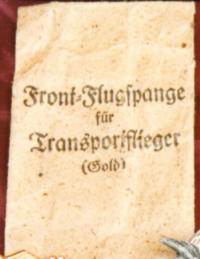
By Paul Williams
To recognize the type and number of operational flights undertaken by aircrew and certain other Luftwaffe personnel, the FRONTFLUGSPANGE (literally "Front Flight Clasp") was progressively introduced from January 1941.
Commonly referred to by collectors as Flight Bars, Operational Flying Clasps or Squadron Clasps, these badges consist of a central device encircled by a wreath of laurel leaves set between two 'wings' of oak leaves. In most designs, the ubiquitous swastika is set at the base of the wreath. Clasps measure around 7.5cm x 2.5cm (3" x 1"). The central device distinguishes between the types of flight undertaken. The color of the clasp, with the exception of the center which is usually blackened, identifies the number of flights achieved. Thus, the BRONZE clasp was awarded for 20 flights SILVER clasp was awarded for 60 flights GOLD clasp was awarded for 100 flights.
Note that a flight was considered "operational" if the enemy was engaged or enemy airspace was penetrated by a given distance. If the number of hours in the air was exceeded by a given amount a single 'sortie' could also be counted as more than one flight towards an award of the Operational Flying Clasp.
THE FIGHTER CLASPS
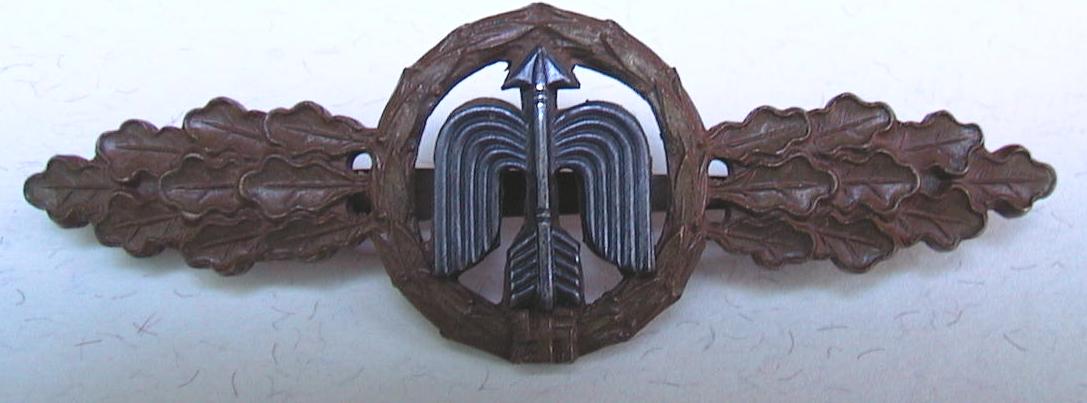
Day Fighter Clasp - Bronze
The central device of the upward pointing winged arrow denotes the award for Short Range Day Fighter. The winged arrow pointing downwards indicates Long Range Day Fighter and , prior to April 1944, Air to Ground Support.

Day Fighter Clasp - Bronze - Reverse View
The reverse of this clasp highlights the typical construction, pin and catch to be found on these awards. The wide tapered pin is almost always encountered, albeit with some variation in shape and colouring - late war clasps by "RS&S" are an exception with a needle pin and ball hinge. Note the absence of a maker's mark on the above example .... the majority of clasps, particularly those of early manufacture, were unmarked. When encountered, some of the makers to be found are:
- G.H. Osang
- Dresden
- R.S.& S.
- R.S.S.
- R.K.
- F & B.L.
- BSW (within a cloverleaf)
- M. Kunststoff
- Gablonz
- C.E. Juncker
- Imme & Sohn
The material / metals used in the construction of these awards were those used for other German military awards of the period. Readers are directed to Andy Hopkins' scholarly article "Badge Construction Techniques" on this website.
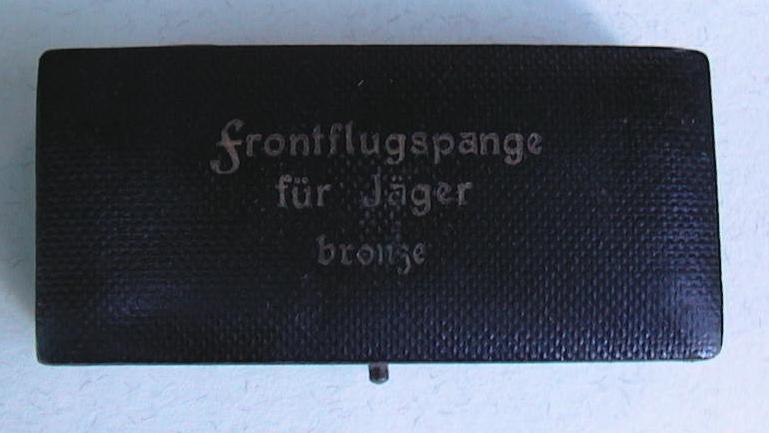
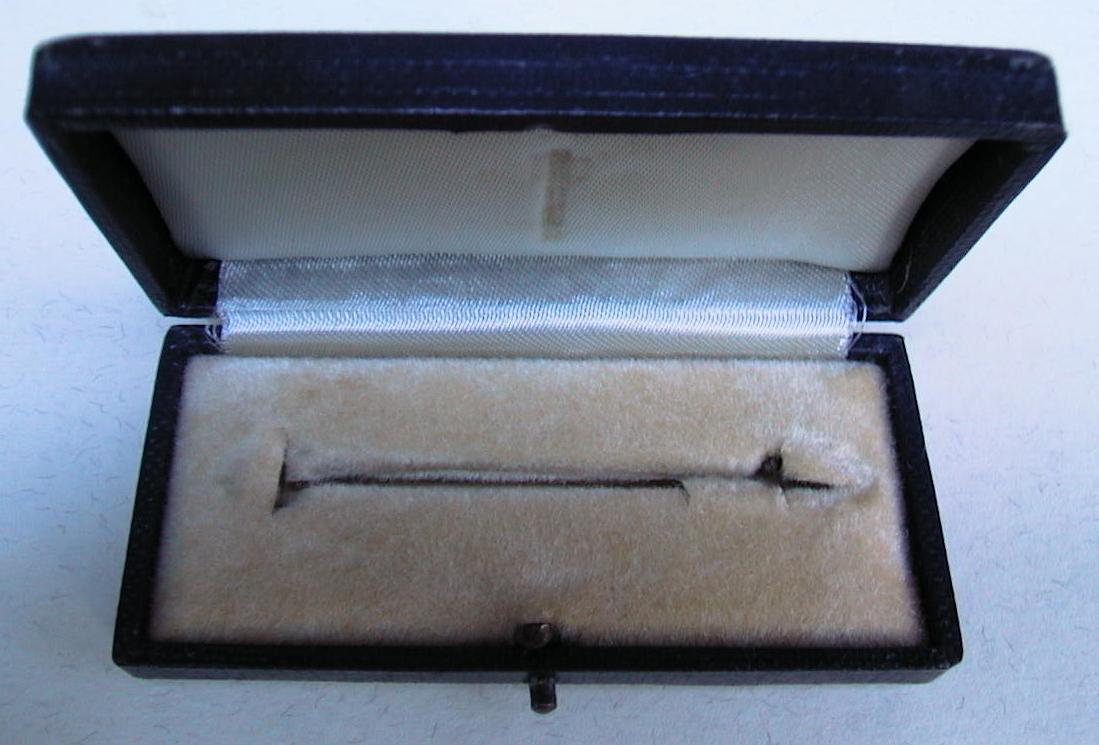
Case for the Fighter Clasp in Bronze
|
|
Clasps were presented in a small, dark blue, rectangular case with the designation of the award imprinted on the lid in gold. These cases measure around 9 x 4 x 1.5cm. Note the materials commonly used to line the case: white silk for the lid and cream colored flocking to form the base. Late in the war, clasps were shipped in simple paper envelopes, similar to other awards of the period. |
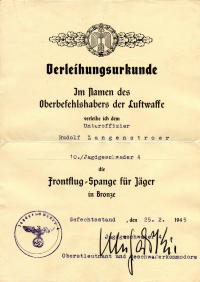
|
A document accompanied the award of a clasp. Here is the document for the Bronze Fighter Clasp awarded to Unteroffizier Rudolf Langenstroer, a pilot who flew with JG4. Note the attractive illustration of the clasp at the top. This is the usual DINA5 (15 x 21cm) sized document. |
This Hoffman postcard of fighter ace Hannes Trautloft shows the regulation positioning of the award on the tunic. Readers will note that Colonel Trautloft's clasp differs from that illustrated above .... please read on!!
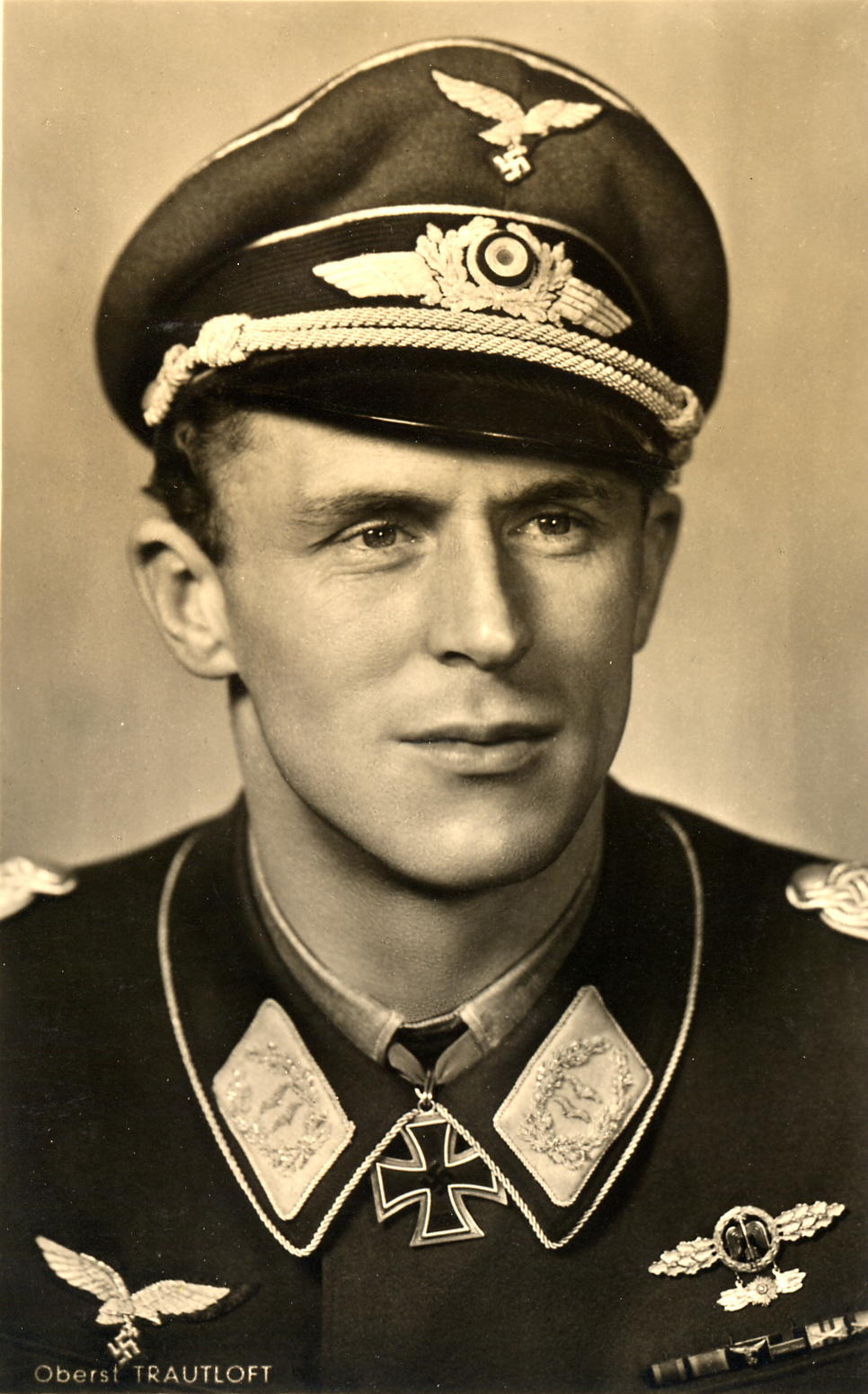
The Bomber Clasp
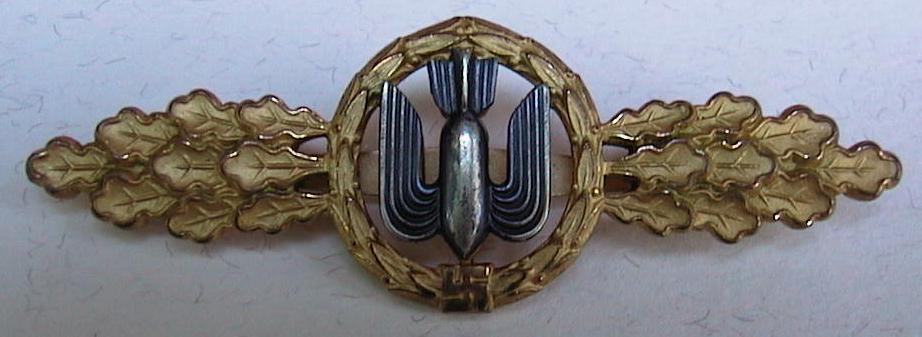
Bomber Clasp in Gold
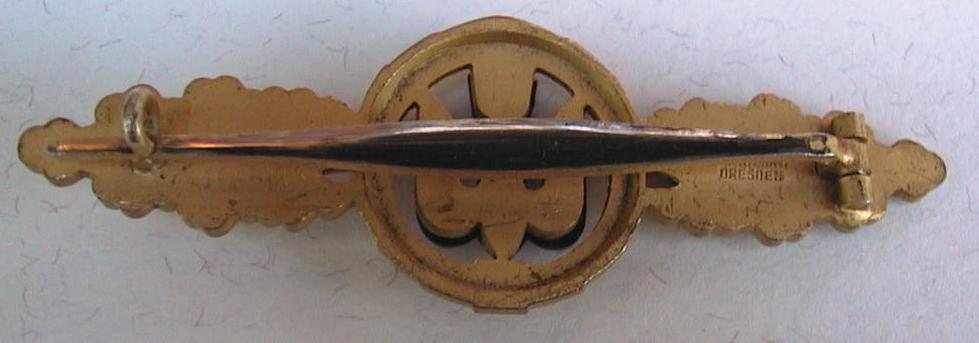
The central device of the winged bomb denotes the award for crews of Heavy, Medium and Dive Bombers. The clasp illustrated is a high quality award manufactured by G.H. Osang of Dresden.Note that clasps were also embroidered in silver wire (officers) and cotton threads (other ranks) as a private purchase option - these are very rare on the collector's market.
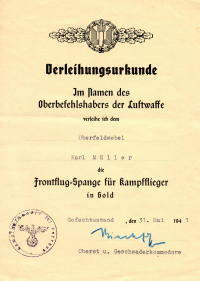 |
The above document for the Gold award of the Bomber Clasp was awarded to pilot Oberfeldwebel Karl Muller who won the Knight's Cross in October 1942 as a member of KG2. |
The Transport and Glider Squadron Clasp
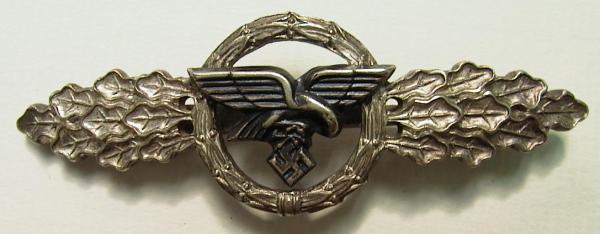
Transport / Glider Clasp in Silver
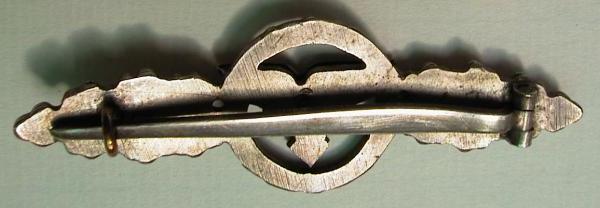
Here the central device of the Luftwaffe eagle flying to the right denotes the award for Transport and Glider Squadron aircrew. Note that in this design the swastika is carried by the eagle, unlike all other clasps where it features at the base of the laurel wreath.
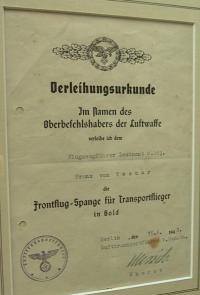
|
The document awarded to Leutnant Franz von Tesmar, a pilot (and adjutant) in a Transport squadron, winner of the German Cross in Gold and the Goblet of Honor. |
Reconnaissance, Air-Sea Rescue and Meteorological Squadron Clasp
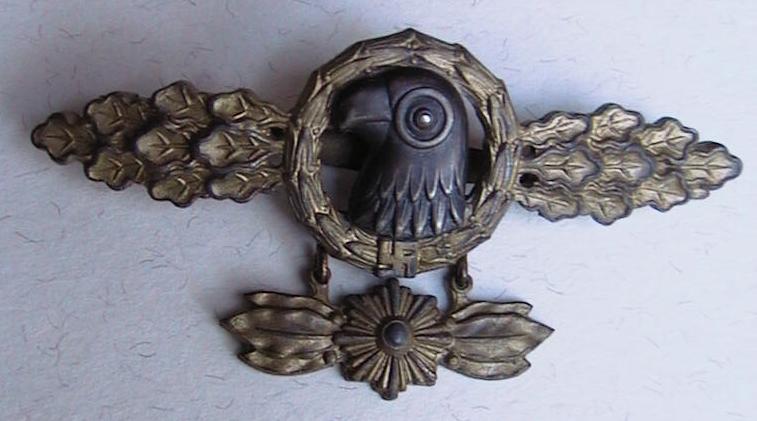
Reconnaissance Clasp in Gold with "Star" Pendant
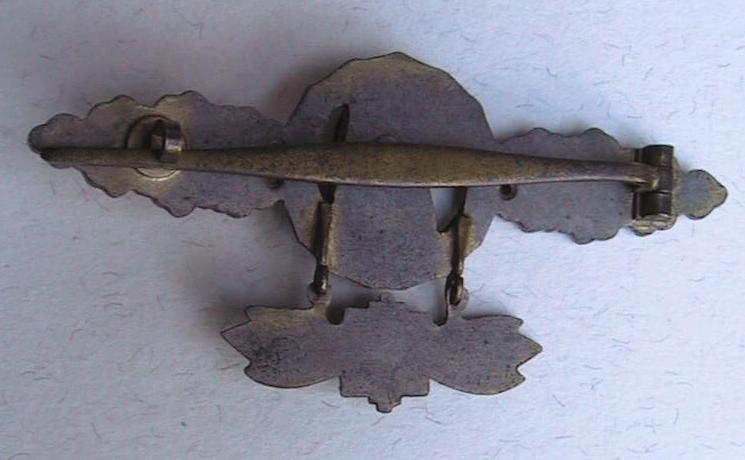
The central device of the eagle's head facing to the right denotes the award to Reconnaissance, Air-Sea Rescue and Meteorological flyers. In this unmarked example note the "star pendant" attached to the basic bar ... as operational flights quickly began to exceed the 110 represented by a Gold award, it became necessary to recognize these achievements by enhancing the badge. Introduced in June 1942, the pendant represents the completion of the following numbers of operational flights:
- Transport and Glider Squadrons - 500 Dive Bomber
- Long Range Day Fighters, Air to Ground Support Squadrons - 400
- Bomber, Air-Sea Rescue, Meteorological Squadrons - 300 Reconnaissance
- Night fighter Squadrons - 250
The other feature of this badge to note is that it is manufactured from zinc alloy. These badges are very commonly found with the original color wash faded, or indeed, non-existent, having been absorbed over time by the base metal. Author Adrian Forman describes these as "crude", and certainly they command less money on the collectors' market. However, they generally maintain a solid standard of construction with sharp detail and serve to inform today's generation of the extreme demands on resources which occur in a war economy - if anything, they are historically interesting!
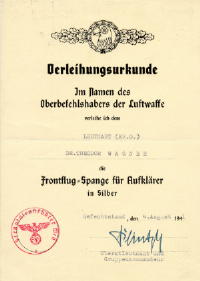
|
The document of the Reconnaissance award in Silver to Leutnant Theodore Wagner, an Observer in an Air-Sea Rescue squadron. Leutnant Wagner won the German Cross in Gold and Goblet of Honor. |
The Air to Ground Support Squadron Clasp
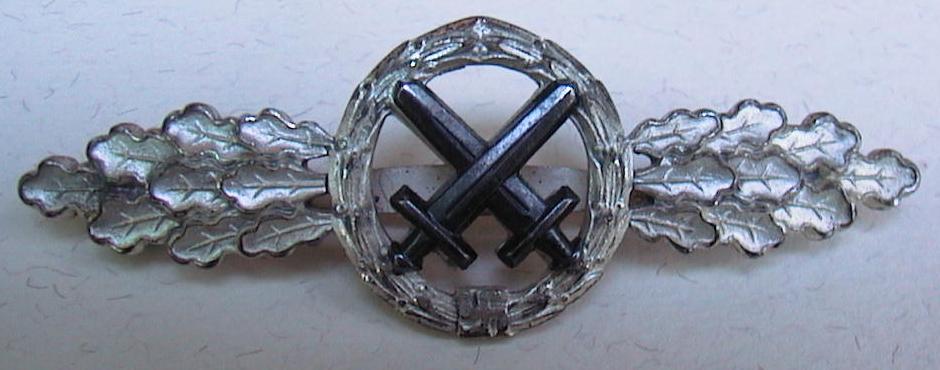
Air to Ground Support Squadron Clasp in Silver
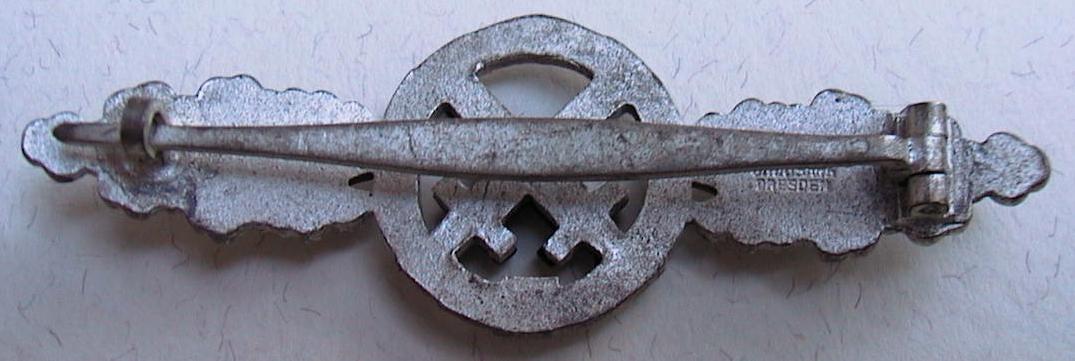
Created in April, 1944, the central device of the crossed swords denotes the award to Air to Ground Support Squadron flyers .... the "Schlachtflieger". Formerly, these personnel were awarded the clasp with the inverted winged arrow (see above). This Osang produced zinc clasp is rather special - it has most of the original finish intact!
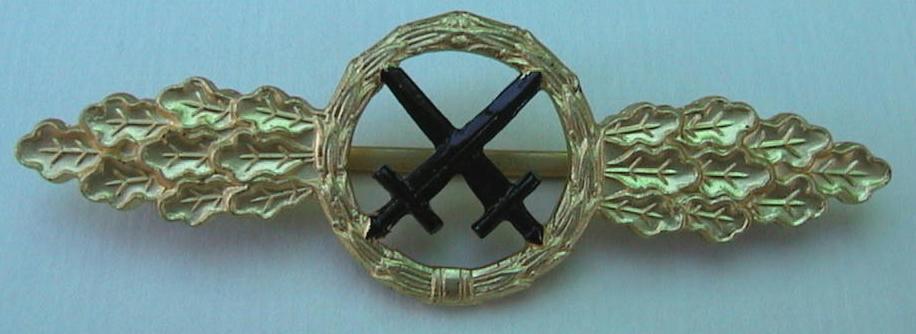
Air to Ground Support Squadron Clasp - 1957 model
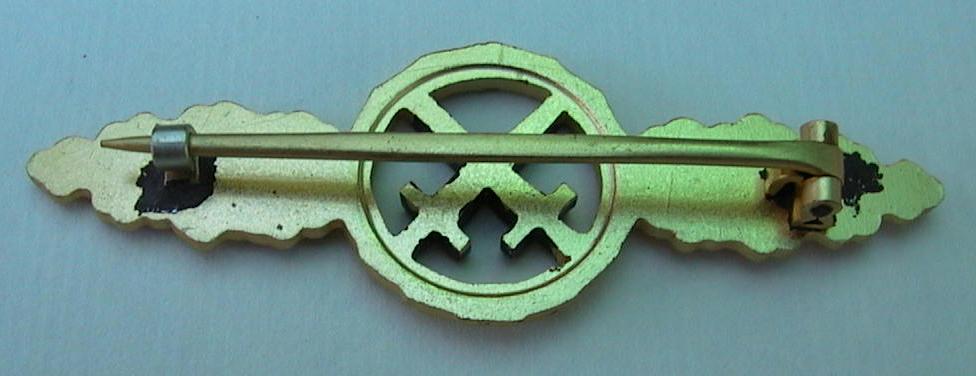
In 1957, along with other WW2 military awards, the West German Government authorised the wearing of clasps of modified design (read - omission of swastika) by Luftwaffe veterans. Note the construction of the badge - all 1957 awards are said to have been manufactured by the one firm - Steinhauer and Luck.
The Night Fighter Clasps

Night fighter Clasp in Gold - photo courtesy Francois Saez
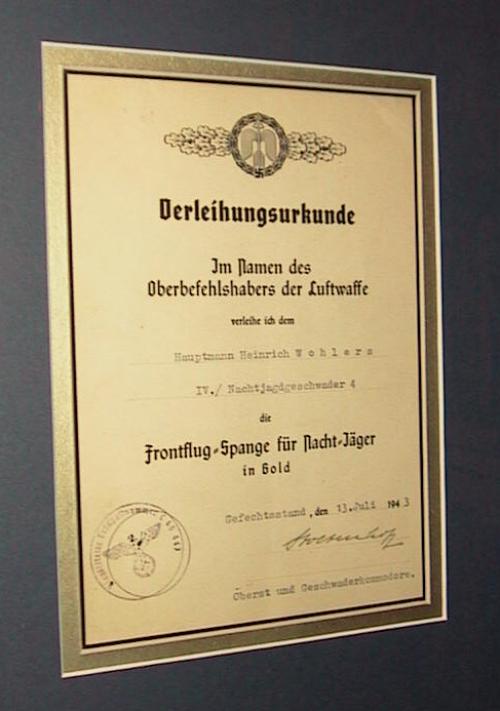 |
This is the rare document for the Night-Fighter Clasp with the usual illustration appearing at the top. The device of the winged arrow is that of the Day Fighter clasp .... but note the blackened wreath, denoting the Nachtjager. Arrow up ... Short Range Night Fighter Squadrons. Arrow down ... Long Range Night Fighter Squadrons. The recipient was Hauptmann Heinrich Wohlers who won the Knight's Cross in December 1943. He scored 29 night victories before his death in March 1944. At the time of the award he was the Gruppenkommandeur of IV./NJG4. He later became Geschwaderkommodore of NJG6. |
The Numbered Pendant
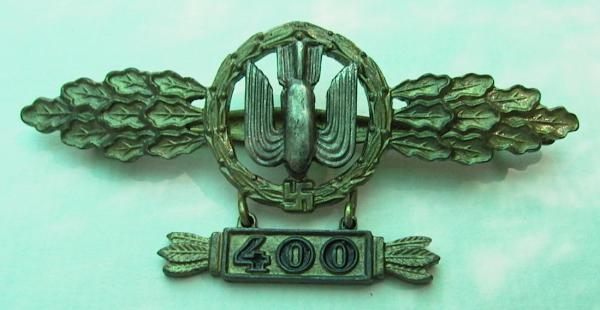
Bomber Clasp in Gold with "400" Pendant
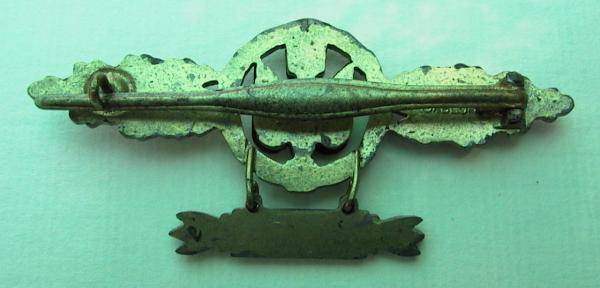
The ever-increasing numbers of flights accomplished by Luftwaffe airmen warranted yet another modification to the Operational Flying Clasp. The numbered pendant was introduced in April, 1944. Bars were produced commencing with the number "200", with increments of "100". Most readers will know of the special "2000" pendant won by Stuka ace Hans-Ulrich Rudel - there were many incredible achievements by other pilots/aircrew within this range. The clasp illustrated is a fine example of the Bomber Clasp in Gold produced by Kunststoff , Gablonz, in zinc alloy.
![]()
© Copyright Wehrmacht-Awards.com LLC |
